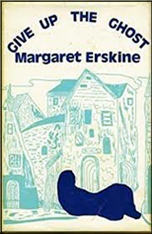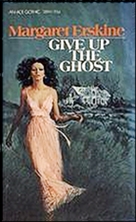Sat 27 Apr 2024
A 1001 Midnights Review: MARGARET ERSKINE – Give Up the Ghost.
Posted by Steve under 1001 Midnights , Reviews[5] Comments
by Ellen Nehr
MARGARET ERSKINE – Give Up the Ghost. Doubleday Crime Club, hardcover, 1949. Mercury Mystery #163, digest paperback, 1953. Ace, paperback, 1970s? [published as part of Ace’s line of Gothic paperbacks].

Margaret Erskine wrote the same book about Scotland Yard inspector Septimus Finch twenty-one times. In each one Finch is described as having a nondescript face and a proclivity for dressing all in gray. This repetition doesn’t enhance the inspector’s limited charms, although it could be argued that his stolidity and matter-of-factness are positive character traits.
In Give Up the Ghost, crude and rather nasty drawings have been sent to the Camborough constabulary, but have been more or less ignored until the elderly housekeeper of the pompous Pleydon family is found murdered with another drawing pinned to her body. None of the Pleydons can suggest any reason for their household’s being singled out, yet several days later another woman connected with them is killed, another drawing near her body. A band of vigilantes is formed to prowl the streets.
Meanwhile Finch, in spite of the Pleydons’ interference, investigates the family’s history and discovers their convoluted, almost forgotten web of financial skulduggery — just in time to prevent further murders. There arc moments of humor amid the gore, such as when Finch installs young Constable Roark in the Pleydon household as a butler.

Erskine — who has stated that writing thrillers was a revolt against her highbrow family — specializes in eccentric British families with long-held secrets, social pretensions, and heads of household who possess streaks of cunning.
As a Scotland Yard officer. Finch solves crimes in Sussex, several seaside towns, and provincial villages. He remains as colorless through his last case, The House on Hook Street (1977), as he was in his first adventure, The Limping Man (1939). Erskine’s novels are definitely an acquired taste.
———
Reprinted with permission from 1001 Midnights, edited by Bill Pronzini & Marcia Muller and published by The Battered Silicon Dispatch Box, 2007. Copyright © 1986, 2007 by the Pronzini-Muller Family Trust.
April 28th, 2024 at 12:07 am
Even dressing Erskine’s Finch novels up as Gothic novels, as they always seemed to be in paperback, couldn’t do much to get readers to turn the pages in the relentless sameness of the Finch saga.
Not that she never had her moments, but I can’t imagine anyone particularly getting behind an Erskine revival.
One of those midlist writers who had an audience who must have been comforted by the repetitive nature, but even if you read one and liked it, there wasn’t much incentive to read a second once you realized there was little new offered.
Still, for whatever reason, she did better with American reprints of her books than many a better more likely writer.
April 28th, 2024 at 12:20 am
A lot of readers must like the comfort of sameness. Think of *all* the Gothic paperbacks published in the 60s and 70s. All in exactly the same theme and mode.
And on the male end of things, all those Executioner books and look-alike’s in about the same era, maybe a little later (1970s and 80s?)
Followed by historical romances and then the cozy fudgemaking and quilting mysteries. Fads come and they go. Most recently what? Probably serial killers and Reacher ripoffs.
April 28th, 2024 at 11:08 pm
I’m reminded of a certain bestselling author whose spy novels feature a woman recruited by his hero to defeat terrorists in every book, and who never lets a book go by without someone being in a certain model of Mercedes Benz.
But the thing about formula is how inventively it can be used and subverted, something not done by Finch. It’s one thing to enjoy certain recurring tropes, and another to practically read the same book every time.
Erskine isn’t a bad writer, just an extremely uninspired one. She seems to have so liked her first book she re wrote it twenty-one times, and I don’t think she was ever popular enough to qualify as a fad or a creator of tropes. If there were Erskine imitators, I don’t know who they were, she barely gets mentioned in most genre history, and I don’t think she was particularly well noticed by critics.
April 29th, 2024 at 2:59 am
Nehr’s judgement that Erskine wrote the same book 21 times is both harsh and unfair. Of Erskine’s books, I have read a half-dozen, and enjoyed them: they are vivid, entertaining, and mystifying, and certainly don’t seem formula-ridden. Yes, they revolve around eccentric families; so do Compton-Burnett’s. The serial killer and frightened town of Give Up the Ghost are quite different from the snowbound House of the Enchantress with its impending uxoricide, the village funerals and African curses of Fatal Relations, or the dilapidated theatre and twisted-necked ghost of Dead by Now. I for one would welcome the reappearance of her works.
April 29th, 2024 at 9:05 pm
Thanks, Nick. It’s good to have an opposing point of view spoken up for, and I’m glad you did.